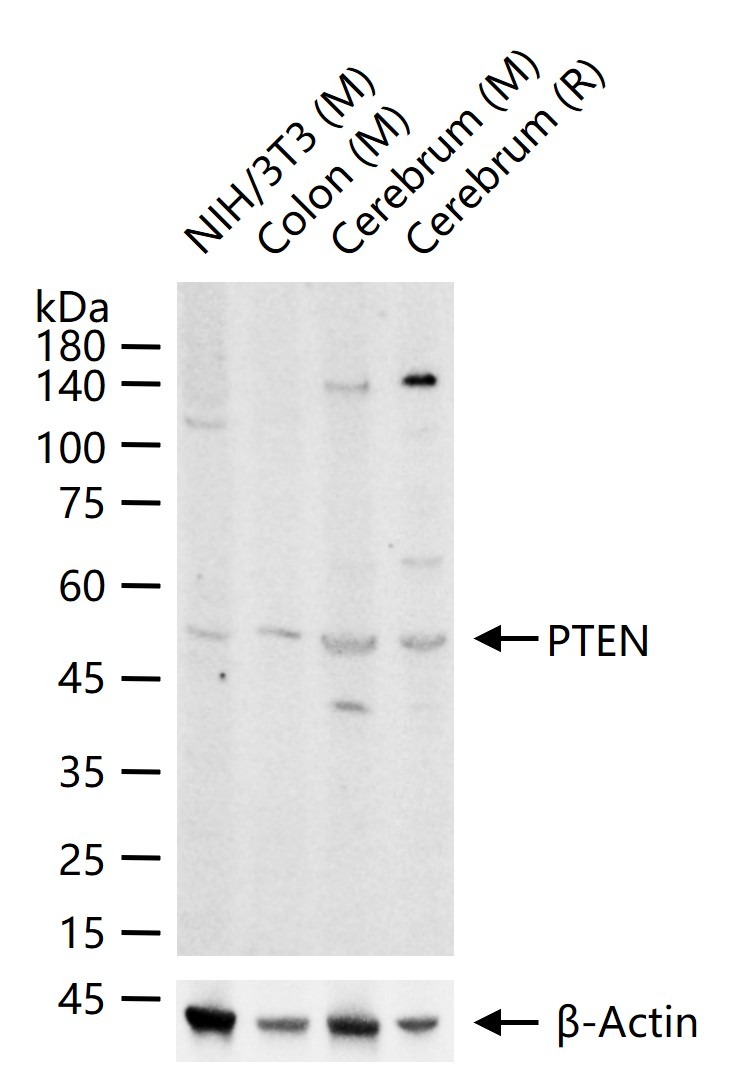Shopping Cart
Remove All Your shopping cart is currently empty
Your shopping cart is currently empty
Anti-PTEN Polyclonal Antibody is a Rabbit antibody targeting PTEN. Anti-PTEN Polyclonal Antibody can be used in WB.
| Pack Size | Price | USA Warehouse | Global Warehouse | Quantity |
|---|---|---|---|---|
| 50 μL | $221 | 7-10 days | 7-10 days | |
| 100 μL | $372 | 7-10 days | 7-10 days | |
| 200 μL | $527 | 7-10 days | 7-10 days |
| Description | Anti-PTEN Polyclonal Antibody is a Rabbit antibody targeting PTEN. Anti-PTEN Polyclonal Antibody can be used in WB. |
| Synonyms | VLA 2 Receptor alpha Subunit, TEP1, TEP 1, Tensin homolog, PTEN1, PTEN 1, Platelet antigen BR, Phosphatidylinositol 345 trisphosphate 3 phosphatase and dual specificity protein phosphatase PTEN, Phosphatidylinositol 345 trisphosphate 3 phosphatase, Phosphatase and tensin like protein, Phosphatase and Tensin Homolog, Mutated in Mutiple Advanced Cancers 1, Multiple hamartoma(Cowden syndrome), MMAC1 phosphatase and tensin homolog deleted on chromosome 10, MMAC1, MMAC 1, MHAM, MGC11227, ITGA 2, GLM2, DEC, BZS a, BZS, Bannayan Zonana syndrome, Bannayan Zonana, 10q23del |
| Ig Type | IgG |
| Reactivity | Mouse,Rat (predicted:Human,Pig) |
| Verified Activity | 25 μg total protein per Lane of various lysates probed with PTEN polyclonal antibody, unconjugated (TMAB-01590) at 1:1000 dilution and 4°C overnight incubation. Followed by conjugated secondary antibody incubation at RT for 60 min.  |
| Application | |
| Recommended Dose | WB: 1:500-2000 |
| Antibody Type | Polyclonal |
| Host Species | Rabbit |
| Subcellular Localization | Cytoplasm. Nucleus. Nucleus, PML body. Note=Monoubiquitinated form is nuclear. Nonubiquitinated form is cytoplasmic. Colocalized with PML and USP7 in PML nuclear bodies. XIAP/BIRC4 promotes its nuclear localization. |
| Tissue Specificity | Expressed at a relatively high level in all adult tissues, including heart, brain, placenta, lung, liver, muscle, kidney and pancreas. |
| Construction | Polyclonal Antibody |
| Purification | Protein A purified |
| Appearance | Liquid |
| Formulation | 0.01M TBS (pH7.4) with 1% BSA, 0.02% Proclin300 and 50% Glycerol. |
| Concentration | 1 mg/mL |
| Research Background | Potential tumor suppressor. Acts as a phosphoinositide3-phosphatase by regulating PtdIns (3,4,5)P3 levels. Involved in regulation of the AKT1 signaling pathway. The unphosphorylated form cooperates with AIP1 to suppress AKT1 activation.The PTEN/MMAC1 discovers the first to have the suppress of the phosphoric acid enzyme activity cancer gene currently.The gene of PTEN locates the chromosome10q23 area, sending forth sex tumor and a few households cancers with the variety to suffer from the comprehensive disease easilyrelevant.The activity that passes to repress the Akt regulates the cell period, the cell ground rule decease and glues to connect.This text discussed PTEN structure, function and its correlationses, the PTEN is in tumor repress function mechanism. |
| Immunogen | KLH conjugated synthetic peptide: human PTEN |
| Antigen Species | Human |
| Gene Name | PTEN |
| Gene ID | |
| Protein Name | Phosphatidylinositol 3, 4, 5-trisphosphate 3-phosphatase and dual-specificity protein phosphatase PTEN |
| Uniprot ID | |
| Biology Area | Phosphatases,PTEN pathway,Phosphatases,Tumor Suppressors,Diabetes,Metabolic disorders,Obesity,Lipid Phosphatases |
| Function | Tumor suppressor. Acts as a dual-specificity protein phosphatase, dephosphorylating tyrosine-, serine- and threonine-phosphorylated proteins. Also acts as a lipid phosphatase, removing the phosphate in the D3 position of the inositol ring from phosphatidylinositol 3,4,5-trisphosphate, phosphatidylinositol 3,4-diphosphate, phosphatidylinositol 3-phosphate and inositol 1,3,4,5-tetrakisphosphate with order of substrate preference in vitro PtdIns(3,4,5)P3 > PtdIns(3,4)P2 > PtdIns3P > Ins(1,3,4,5)P4. The lipid phosphatase activity is critical for its tumor suppressor function. Antagonizes the PI3K-AKT/PKB signaling pathway by dephosphorylating phosphoinositides and thereby modulating cell cycle progression and cell survival. The unphosphorylated form cooperates with AIP1 to suppress AKT1 activation. Dephosphorylates tyrosine-phosphorylated focal adhesion kinase and inhibits cell migration and integrin-mediated cell spreading and focal adhesion formation. Plays a role as a key modulator of the AKT-mTOR signaling pathway controlling the tempo of the process of newborn neurons integration during adult neurogenesis, including correct neuron positioning, dendritic development and synapse formation. May be a negative regulator of insulin signaling and glucose metabolism in adipose tissue. The nuclear monoubiquitinated form possesses greater apoptotic potential, whereas the cytoplasmic nonubiquitinated form induces less tumor suppressive ability. |
| Molecular Weight | Theoretical: 44 kDa. |
| Stability & Storage | Store at -20°C or -80°C for 12 months. Avoid repeated freeze-thaw cycles. |
| Transport | Shipping with blue ice. |
| Size | Quantity | Unit Price | Amount | Operation |
|---|

Copyright © 2015-2026 TargetMol Chemicals Inc. All Rights Reserved.